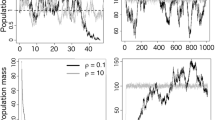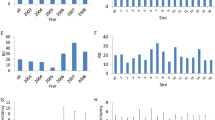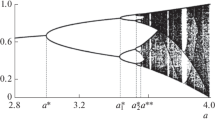Abstract
The probability of, and time to, fixation of a mutation in a population has traditionally been studied by the classic Wright–Fisher model where population size is constant. Recent theoretical expansions have covered fluctuating populations in various ways but have not incorporated models of how the environment fluctuates in combination with different levels of density-compensation affecting fecundity. We tested the hypothesis that the probability of, and time to, fixation of neutral, advantageous and deleterious mutations is dependent on how the environment fluctuates over time, and on the level of density-compensation. We found that fixation probabilities and times were dependent on the pattern of autocorrelation of carrying capacity over time and interacted with density-compensation. The pattern found was most pronounced at small population sizes. The patterns differed greatly depending on whether the mutation was neutral, advantageous, or disadvantageous. The results indicate that the degree of mismatch between carrying capacity and population size is a key factor, rather than population size per se, and that effective population sizes can be very low also when the census population size is far above the carrying capacity. This study highlights the need for explicit population dynamic models and models for environmental fluctuations for the understanding of the dynamics of genes in populations.
Similar content being viewed by others
References
Crow, J. F., & Kimura, M. (1970). An introduction to population genetics theory. New York: Harper and Row Publishers.
Engen, S., Lande, R., & Saether, B.-E. (2005). Effective size of a fluctuating age-structured population. Genetics, 170, 941–954.
Engen, S., Lande, R., & Saether, B.-E. (2009). Fixation probability of beneficial mutations in a fluctuating population. Genet. Res. Camb., 91, 73–82.
Fisher, R. A. (1930). The distribution of gene ratios for rare mutation. Proc. R. Soc. Edinb., 50, 204–219.
Frankham, R. (1995). Effective population size/adult population size ratios in wildlife: a review. Genet. Res., 66, 95–107.
Gale, J. S. (1990). Theoretical population genetics. London: Unwin Hyman Ltd.
Haldane, J. B. S. (1927). A mathematical theory of natural and artificial selection. Part V: Selection and mutation. Proc. Camb. Philos. Soc., 23, 838–844.
Iizuka, M. (2001). The effective size of fluctuating populations. Theor. Pop. Biol., 59, 281–286.
Kaitala, V., Ranta, E., & Stenseth, N. C. (2006). Genetic structuring in fluctuating populations. Ecol. Inform., 1, 343–348.
Kimura, M. (1962). On the probability of fixation of mutant genes in a population. Genetics, 47, 713–719.
Kimura, M., & Crow, J. F. (1963). The measurement of effective population number. Evolution, 17, 279–288.
Kimura, M., & Ohta, T. (1969). The average number of generations until fixation of a mutant in a finite population. Genetics, 61, 763–771.
Lambert, A. (2006). Probability of fixation under weak selection: a branchin process unifying approach. Theor. Pop. Biol., 69, 419–441.
Lande, R. (1994). Risk of population extinction from fixation of new deleterious mutations. Evolution, 48, 1460–1469.
Otto, S. P., & Whitlock, M. C. (1997). The probability of fixation in populations of changing size. Genetics, 146, 723–733.
Parsons, T. L., & Quince, C. (2007). Fixation in haploid populations exhibiting density dependence I: The non-neutral case. Theor. Pop. Biol., 72, 121–135.
Parsons, T. L., Quince, C., & Plotkin, J. B. (2008). Absorption and fixation times for neutral and quasi-neutral populations with density dependence. Theor. Pop. Biol., 74, 302–310.
Ranta, E., Lundberg, P., & Kaitala, V. P. (2006). Ecology of populations. Cambridge: Cambridge University Press.
Ranta, E., Kaitala, V., Björklund, M., Lundberg, P., Bach, L. A., & Stenseth, N. C. (2008). Climate forcing and genetic differentiation in subdivided populations. Evol. Ecol. Res., 10, 1–9.
Ricker, W. E. (1954). Stock and recruitment. J. Fisheries Res. Board Can., 11, 559–623.
Ripa, J., & Lundberg, P. (1996). Noise colour and the risk of population extinctions. Proc. R. Soc. Lond. B, 263, 1751–1753.
Sano, A., Shimizu, A., & Iizuka, M. (2004). Coalescent process with fluctuating population size and its effective size. Theor. Pop. Biol., 65, 39–49.
Schwager, M., Johst, K., & Jeltsch, F. (2006). Does red noise increase or decrease extinction risk? Single extreme events versus series of unfavorable conditions. Am. Nat., 167, 879–888.
Wright, S. (1931). Evolution in Mendelian populations. Genetics, 16, 97–159.
Wright, S. (1969). Evolution and the genetics of natural populations, vol. 2. The theory of gene frequencies. Chicago: Chicago University Press.
Author information
Authors and Affiliations
Corresponding author
Additional information
E. Ranta deceased August 2008.
Rights and permissions
About this article
Cite this article
Björklund, M., Ranta, E., Kaitala, V. et al. Environmental Fluctuations and Level of Density-Compensation Strongly Affects the Probability of Fixation and Fixation Times. Bull Math Biol 73, 1666–1681 (2011). https://doi.org/10.1007/s11538-010-9587-3
Received:
Accepted:
Published:
Issue Date:
DOI: https://doi.org/10.1007/s11538-010-9587-3




